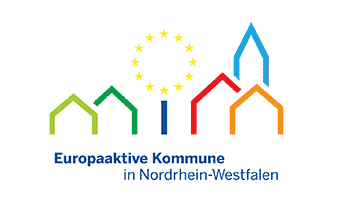Inhalt
Historischer Rundweg - Board II
Windmill
The building is a typical windmill variety found in the Lower Rhine region
This heritage building stems from the first half of the 19th century and is, together with the church spire, the second most visible landmark for miles around in Wemb.
In the Lower Rhine region, where the wind can blow without hinderance, the best conditions are available for the operation of windmills. Here they are obvious landmarks. For centuries they had the task of processing agricultural products into grain and oilseeds. Each town and each village had its own windmill or in some cases more than one.
The Wemb windmill next to the church spire is the second most visible landmark in Wemb for miles around. The building, of the building type “Erdholländer” (built level with the ground) is a typical windmill variety found in the Lower Rhine region. It is a rare and important witness of the preindustrial history of the Lower Rhine landscape and an important heritage building for the village of Wemb, postcards of which were sent all over the World.
For generations in family ownership
The mill was purchased half-built by the local Stammen Family. Several building owners ran out of money, so that the building remained uncompleted and for a long period was commonly known as the “Wember Tonne” (Wemb’s barrel). Gerhard Anton Stammen fitted a thatched roof around 1860 and attached the blades to the windmill. Alexander Stammen inherited the windmill and the bakery from his father and handed them over to his son Gerhard in 1935. Up until 1954 miller and bakery master Gerhard Stammen produced flower with wind power, had the blades removed in 1955 and continued grinding until 1960 using electricity. From 1969 to 2003 his son Heinrich continued operating the bakery and the food store. Bread as well as other food were not bought "at Stammen's" but as it was known in Wemb "at the miller's" (bej den Mölder).
Use as living quarters
When Helene Stammen married architect Matthias Selders in 1961 and was given the windmill by her father Gerhard, they thought about how they could use the building sensibly. Mathias Selders drew up a plan, which converted the heritage building up until today into an attractive residential building. He surrounded the mill tower with a ground level extension. The mill became the entrance to the flat, into which the Selders couple moved. In the mid-sixties this became too small and so the family moved to Kevelaer. At the beginning of the 1970s the family, now numbering seven, moved back into the windmill, because Mathias Selders had over the years extensively and spaciously extended the small flat.
New brickwork, new blades, new roof
In the last decades the Selders family invested in the maintenance and look of the mill. In 1980 the mill tower was rebricked. In 1988 the windmill was once again fitted with blades. With funding from the municipality, county and the federal state the owner Helene Selders, now a widow with five children, was able to accomplish these tasks. A Dutch mill building company fitted the about 8 metre long blade on the mill head. Since then the building has the look that was a pleasant sight for young and old decades before. After the death of Helene Selders in 1990 the building was rented out. Since 2003 the youngest son, master carpenter Wolfgang Selders, and his family live in the windmill on Schafweg 1. Just like his parents he is keen on maintaining the heritage building. In 2010 he replaced the thatched roof with a tin one and two years later had energy saving alterations carried out. The maintenance of the Wemb windmill, even today, is a challenge for the owner.
Removal of the grinding stones. Pictured is Gerhard Stammen, the last Miller in Wemb who operated the windmill until 1960
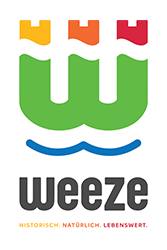

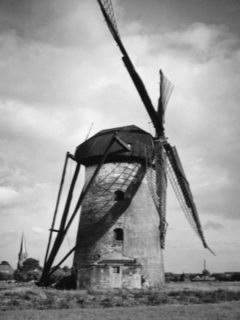
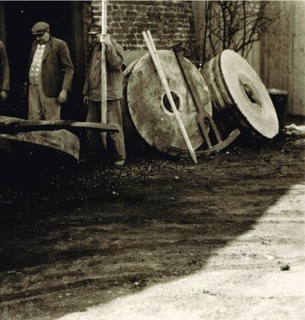
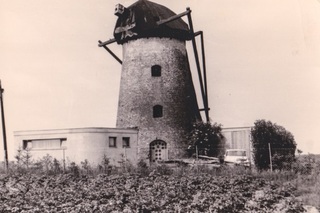
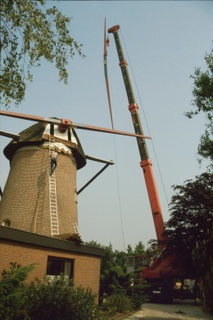
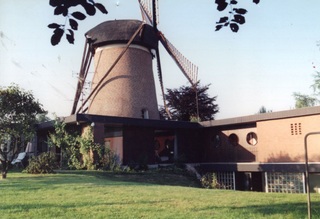
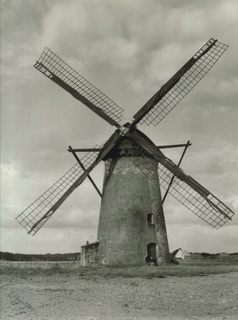
 02837 9100 (Zentrale)
02837 9100 (Zentrale) info@weeze.de
info@weeze.de Facebook
Facebook